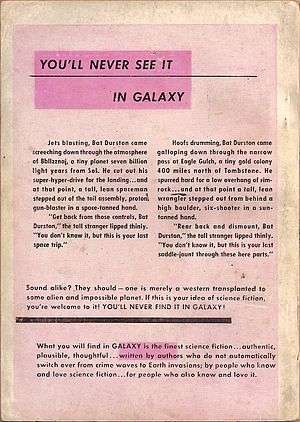Space Western

Space Western is a subgenre of science fiction which uses the themes and tropes of Westerns within science fiction stories. Subtle influences may include exploration of new, lawless frontiers, while more overt influences may feature literal cowboys in outer space who use ray guns and ride robotic horses. Although initially popular, a strong backlash against perceived hack writing caused the genre to become a more subtle influence until the 1980s, when it regained popularity. A further critical reappraisal occurred in the 2000s with Firefly.
Setting
A space Western may emphasize space exploration as "the final frontier". These Western themes may be explicit, such as cowboys in outer space, or they can be a more subtle influence in space opera.[1] Gene Roddenberry described Star Trek: The Original Series as a space Western.[2] Firefly and its cinematic follow-up Serenity literalized the Western aspects of the genre popularized by Star Trek: it used frontier towns, horses, and the styling of classic John Ford Westerns.[3][4] Worlds that have been terraformed may be depicted as presenting similar challenges as that of a frontier settlement in a classic Western.[5] Six-shooters and horses may be replaced by ray guns and rockets.[6]
History

Westerns influenced early science fiction pulp magazines. Writers would submit stories in both genres,[7] and science fiction magazines sometimes mimicked Western cover art to showcase parallels.[8] In the 1930s, C. L. Moore created one of the first space Western heroes, Northwest Smith.[8] Buck Rogers and Flash Gordon were also early influences.[6] After superhero comics declined in popularity in 1940s America, Western comics and horror comics replaced them. When horror comics became untenable with the Comics Code Authority in the mid-1950s, science fiction themes and space Westerns grew more popular.[8] By the mid-1960s, classic Western films fell out of favor, and Revisionist Westerns supplanted them. Science fiction, such as Lost in Space,[9] Star Trek, presented a new frontier to be explored, and films like Westworld rejuvenated Westerns by updating them with science fiction themes. Peter Hyams, director of Outland, said that studio heads in the 1980s were unwilling to finance a Western, so he made a space Western instead. Space operas such as the Star Wars film series also took strong cues from Westerns; Boba Fett, Han Solo and the Mos Eisley Cantina in particular were based on Western themes. These science fiction films and television series offered the themes and morals that Westerns previously did.[10]
This frontier view of the future is only one of many ways to look at space exploration, and not one embraced by all science fiction writers. The Turkey City Lexicon, a document produced by the Turkey City science fiction writers' workshop, condemns the space Western as the "most pernicious" form of a pre-established background that avoids the necessity of creating a fresh world.[11] Galaxy Science Fiction ran an advertisement on its back cover, "You'll never see it in Galaxy", which gave the beginnings of make-believe parallel Western and science fiction stories featuring a character named Bat Durston.[12] Such scathing attacks on the subgenre, along with further attacks on space operas, caused a perception that all space Westerns were by definition hack writing and not "true" science fiction. Although the underlying themes remained influential, this bias persisted until the 1980s, when the release of Outland and children's cartoons, such as Bravestarr and The Adventures of the Galaxy Rangers, repopularized explicit themes of cowboys in space. In the 1990s, anime series, such as Outlaw Star and Trigun became prime examples of the genre. In the 2000s, Firefly won critical acclaim, further causing a critical reassessment of space Westerns.[6] Games such as StarCraft[13][14] and the Borderlands series have also popularized the space Western theme.[15]
See also
References
- ↑ Green, Paul (2009). Encyclopedia of Weird Westerns. McFarland Publishing. pp. 3–4. ISBN 9780786458004.
- ↑ "A First Showing for 'Star Trek' Pilot". The New York Times. 1986-07-22. Retrieved 2014-03-13.
- ↑ Murray, Noel; Bowman, Donna (2012-06-01). "Firefly: "Serenity"". The A.V. Club. Retrieved 2014-03-13.
- ↑ Franich, Darren (2013-09-24). "The Simultaneous Deconstruction and Reconstruction of Clichés". Entertainment Weekly. Retrieved 2014-03-13.
- ↑ Sawyer, Andy (2009). Bould, Mark; Butler, Andrew; Roberts, Adam; et al., eds. The Routledge Companion to Science Fiction. Routledge. p. 508. ISBN 9781135228361.
- 1 2 3 Lilly, Nathan E. (2009-11-30). "The Emancipation of Bat Durston". Strange Horizons. Retrieved 2014-03-14.
- ↑ Westfahl, Gary, ed. (2005). The Greenwood Encyclopedia of Science Fiction and Fantasy. Greenwood Publishing Group. p. 888. ISBN 9780313329524.
- 1 2 3 Green, Paul (2009). Encyclopedia of Weird Westerns. McFarland Publishing. pp. 10–14. ISBN 9780786458004.
- ↑ pg 131 Irwin Allen Television Productions, 1964-1970: A Critical History of Voyage. October 3, 2006
- ↑ Steinberg, Don (2011-07-22). "Hollywood Frontiers: Outer Space and the Wild West". The Wall Street Journal. Retrieved 2014-03-15.
- ↑ Sterling, Bruce (2009-06-18). Shiner, Lewis, ed. "A Primer for SF Workshops". Science Fiction and Fantasy Writers of America. Retrieved 2014-03-14.
- ↑ "You'll Never See It in Galaxy". Galaxy Science Fiction. 1 (1). October 1950.
- ↑ N.E. Lilly. "10 Most Influential Space Westerns". SpaceWesterns.com.
- ↑ Cowen, Nick (23 January 2013). "Battle.net Championship wows the masses as gamers play to the crowds". The Guardian.
- ↑ "Borderlands 2: the cult hit space western game returns". The Week. 2012-09-18. Retrieved 2014-10-22.
Further reading
- Abbott, Carl, Frontiers Past and Future: Science Fiction and the American West, University Press of Kansas, 2006.
- Katerberg, William H., Future West: Utopia and Apocalypse in Frontier Science Fiction, University Press of Kansas, 2008.
- Mogen, David, Wilderness Visions: The Western Theme in Science Fiction Literature, Borgo Press, 1993.
- Westfahl, Gary, Space and Beyond: The Frontier Theme in Science Fiction, Greenwood Press, 2000.
- Gunn, James (1995). "Teaching Science Fiction". Center for the Study of Science Fiction. University of Kansas. Retrieved 2006-01-15.
- Priestley, J. B. (December 5, 1953) "Thoughts in the Wilderness." New Statesman.